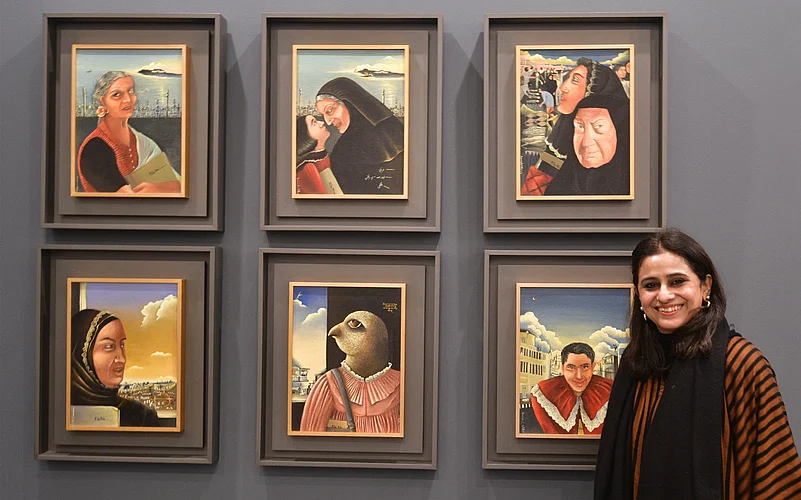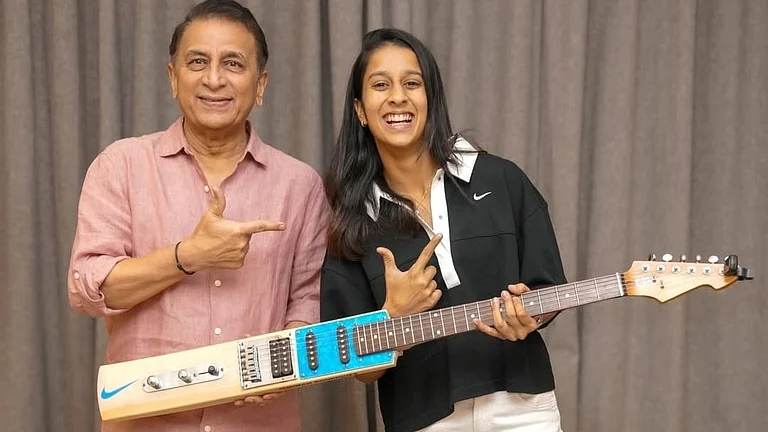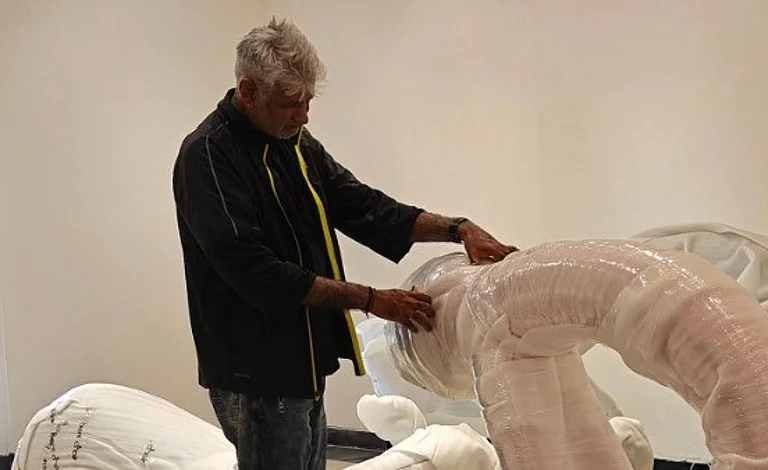The glass eye of S glints out of a dark frame as a reminder of her loss. Perhaps the only record of what she gained and lost in this life. S lost her eye during the Bhopal Gas tragedy of 1984 which killed thousands. While the official death toll was 3,928, activists claim over 8,000 died. And those who lived, like S, lived with the memory of the loss.
On display at the bustling India Art Fair, New Delhi, the portrait is part of the series, ‘I Didn’t Ask for Fish Bones: Notes on Songs of Abundance’, as a document of women like S who were given the leanest of life’s offerings and then erased from living memory.
“They are just being offered fish bones. It’s enough to sustain the body. But the soul eventually gets erased,” says Baaraan Ijlal, the painter of the portraits. Born and raised in Bhopal, Baaraan and her historian-artist brother Moonis (who is a co-exhibitor at the Fair) have been preoccupied with the ideas of anonymity and space. While Baaraan’s portraits of women depict their lives as ‘case files’ pending their hearing, Moonis depicts ‘men-without-women’ in urban spaces, living virtual, make-believe lives on their ‘Lie Machines’—the title of the collection. These men continue to look at their phones or look away while the world burns.
The silent, ominous soldiers and imploding missiles in the background of Moonis’ men and the eyebrows above the questioning eyes of the women in burqas at the fish market painted by Baaraan are uneasy reminders of where the duo comes from and the socio-political anxieties of a large section of people in India’s polarised religious landscape today. But the duo maintain that their work deals more with universal themes like erasure, transition and preservation of memory.
Erasure seems to be a constant theme in the works of women artists at the Fair. Artist Shilpa Gupta’s line drawings depict police brutality and censorship in a bid to fight another kind of erasure. She describes her work in her concept note: “The absent, dissenting body, despite its expulsion, affirms its prescience by claiming space and encircling the area around the presence.” Drawn between 2014 and the present, the series titled ‘Nothing Will Go On Record’ is one of the rare pieces of protest at the Fair which consists of 109 exhibitions across mediums and works of 72 galleries, featuring both young artists like Pallavi Singh and veterans like Kanchan Chandra.
Born in Ballia, a conservative region in western Uttar Pradesh where regressive gender roles are normative, Singh was always bothered by the perception of “beauty and grooming” specifically as a female trait. Her intimate portraits, part of her ‘The Bather’ series, depict men preening and brushing their hair in front of a mirror, presumably after a shower. These men have a candid, soft, sensual demeanor. “Whenever we think of beauty or bathing, we only think of women because all imagery around it depicts women, usually painted or created by men. With this series, I have tried to invert the male gaze by depicting how a man in his intimate moments might look like when seen by a woman,” she says.

Sensuality and the female body feature the works of other women artists like Shilo Shiva Suleman and Kanchan Chandra. Suleman’s yonic golden sculpture declares to the world that ‘God is a Woman in Love’ and forms the centrepiece of the ‘Venusian Kingdom of Overgrown Orchids’. The gilded portraits that form part of the collection delve into the folds of Hindu mythology for their erotic undercurrents. Chandra depicts the female form in its most corporeal, without face or limbs, a nameless entity that bears pain and suffering but is also the source of strength, resilience and birth. Chandra is also drawn to portraits of ‘tragedy queens’.

While the busts are decorated by kitschy prints of Amrita Pritam and Freida Kahlo, the bejewelled eyes of Meena Kumari, Audrey Hepburn, and Marilyn Monroe follow one around the gallery. The collection is more personal than it may appear. “This series (‘Hollywood-Bollywood’) perhaps represents my own childhood desire of wanting to become an actress,” Chandra says with a laugh. In contrast, the melancholy padded canvasses created by Anju Dodiya as part of her ‘Bridge of Restlessness’ collection evoke a sense of “mournful restlessness”. She too draws from tragic women from the past like Daphne from Greek myth, who was turned into a tree by her father to evade the lustful Apollo.

Artists like Mayuri Chari and Sonal Varshney have focused on highlighting the invisible labour and financial contributions of women. Goa-born Chari’s booth exhibits her signature threaded portraits of the female form with a dotted, yellow saree as the centrepiece depicting the strife of indentured women sugarcane workers in labour camps. The sarees were used by women working and living in the camps as the only means of privacy in the absence of walls. These women faced exploitation of labour and were also vulnerable to human trafficking. The saree becomes a metaphor for their enduring pain, suffering and resilience.
Varshney also focuses on women’s labour, but in financial terms. Her series, ‘Ghar Ki Laxmi’ brings together a collage of portraits of women in order to highlight the various invisible ways in which women contribute to the household economy without any recognition or reward. It urges viewers to reflect on the many forms of unpaid labour women perform endlessly to ensure the perpetuity of the “family unit”.

Displacement and memory are also common motifs used by Sadhna Prasad and Ekta Singha. Prasad, one of the Digital Artists in Residence at the fair this year, dabbles in augmented reality to depict the contiguities of environmentalism, class and urban life. The gigantic, vibrant mural, which morphs when seen through an app on an iPad, depicts the dual realities of urban life. The themes of community living and displacement lay under the veneer and layers of paint. Singha uses layers too, in her textile-based artwork, which serve as a memory archive of her mixed Indian and Bangladeshi roots. In a stroke of introspection, Singha adds her own image among the layers, an entity chained to her roots.

The histories and alternate realities these women try to depict are largely stories of women and the marginalised that remain in the footnotes. Artists like Baaraan hope that their art helps to bear witness to the various burdens of inequality that women bear.
The focus on "universality", however, fails to take into account the hierarchies of neglect that women across the divides of class, caste and religion face. Some women have historically remained more vulnerable to abuse due to their socio-political and economic status. Even in the world of art, privilege remains key to access, the first step to exposure that facilitates patronage which is essential for an artist's survival. Near the end of the last pavilion at the Fair is a booth displaying artworks by tribal artists, including veteran Bhil artist Bhuri Devi. The Padma Shri winner is not present at the event. She was awarded the Padma Shri for her valuable contributions to Indian and indigenous art, but this is the first time her work, in her nearly 70 years of being an artist, has made it to a commercial, high-end, global platform like the India Art Fair. While many artists at the India Art Fair attempt to highlight erasure and alternate histories through their creations, the space itself remains exclusive.


























